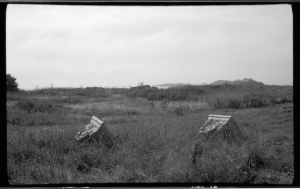In my last post I announced that the Antarctica photos would be shown starting in late January 2017. When the curator looked at that work, he also saw a project I did in the late 1980s, early 1990s, on the granite quarry industry on the islands of Maine. He felt both sets of images would work well together and after some initial reluctance, I agreed. They are both about big things, icebergs and granite blocks, that reflect man’s indirect or direct effect on his surroundings.
Below is what I wrote about the work when I first exhibited the images in the 1990s. However, the three images only sort of reflect the actual work. In real life each photo below is a part of a larger piece that combines two or more photos with text. The pieces range in size from 36 inches by 42 inches up to 42 inches by 72 inches. The long, narrow panorama at the bottom is actually 42 inches high by 18 feet long.
The text might discuss the nature and mineral composition of granite in one and in another discuss the health and safety issues the quarrymen faced. One covers the socialist and union activities on an island as the workers and management fought it out. It was a brutal industry that endangered the workers and left them to the whims of the owners who often would pit one ethnic group against another.
Enough of this. I will discuss one complete image more in-depth in the future. Stay tuned!

High Island, Mussel Ridge Channel, the first quarry I explored with my older boat, Jeanne, at anchor.
Sailing on the coast of Maine since the early 1980s, I would occasionally see large granite wharves on some of the islands. I wondered who built them and for what reason they’d be on what seemed to be wild, uninhabited islands. Finally, one day in the summer of 1988, while waiting for the fog to lift, I rowed ashore on one of these islands to explore. Finding nothing, I assumed that the island had been uninhabited forever. But as I sailed back to Portland, I made note of all the islands with large wharves. During the winter, my research revealed that these had been granite quarry islands, and at one time had been part of a huge industry in Maine.
In the summers of 1989 and 1990, I visited every quarry island from Port Clyde to east of Jonesport that could only be accessed by boat. If I could easily drive to the quarry, I didn’t photograph it. Some had been small, one-man “motions;” others had been large, two-thousand-man sites. When I started the Granite Quarry project, I realized the story I really wanted to tell was that of the men who worked the quarries. I wanted to pay tribute to them and indirectly pay tribute to my grandfather who, like them, was an immigrant who came here looking for work. He was a modeler who made the patterns for the ornamental iron and bronze work that adorned many of the buildings and monuments constructed in the 1920s, 1930s and 1940s. It’s really easy to make very beautiful photographs of these quarries, But this project is about the men who worked the quarries and carved the stone. Almost all were immigrant, blue-collar workers, and many of them highly skilled. These were men two generations older than my grandfather. This project is a tribute to these men and also to my grandfather.

Dix Island, next to High, that at one time had three quarries and a cutting shed where the carvers created beautiful blocks, like these capitals. They are all that remain on Dix today of this industry.
Photographs, like archaeological remains, are often incomplete. They address what’s in front of the lens, but they can only suggest the entirety of that which was once present. These photographs record the physical traces of the granite industry that flourished on the islands off the coast of Maine during the Beaux-Arts building boom which existed during the period of economic growth between the Civil War and World War I. In the 1890s, Maine shipped more tonnage of stone than any other state in the Union. That stone built many of the monumental private and public buildings, churches and bridges, and even paved the streets on the Eastern Seaboard. The population on the granite islands of Penobscot Bay grew from a few families of sheepherders and fishermen to hundreds and even up to two-thousand quarrymen and stone cutters on some of the larger island quarries. These islands had boarding houses, churches, town halls, and schools to serve the men who came from Ireland, Scotland, Italy, Finland, Sweden, and other countries to work. One even had a 450-seat opera house.

Palmer Quarry, on Vinalhaven, where the columns for St. John the Divine were quarried.
By the start of World War I, the new steel-reinforced concrete technology replaced building with granite blocks. Also, railroads became a cheaper means of transportation than sailing vessels, so island granite became expensive. Today, barely a trace of this industry or of these immigrant workers remains.

hello John, this is john jaffray from mpls. are you jack eide’s son of blake school? thx
jsjaffray@gmail.com
Looking forward to the show.